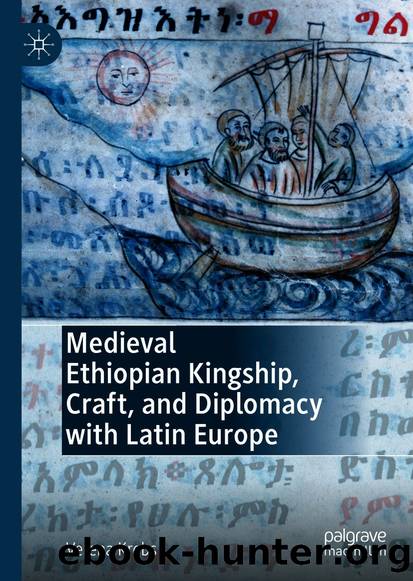Medieval Ethiopian Kingship, Craft, and Diplomacy with Latin Europe by Verena Krebs

Author:Verena Krebs
Language: eng
Format: epub
Publisher: Springer International Publishing
Two months later, a version of this letter had already been printed in Rome, testifying to the considerable Latin Christian excitement about this first Solomonic mission to Europe in decades. In late February 1514, Æleniâs envoys Mateus and YaÊ¿Çqob finally arrived at the court of Manuel I of Portugal.211 The Portuguese humanist Damião de Góis,212 then a page in royal employ, witnessed their reception as a young boy.213 Nearly 20 years later, he described the events in a letter to a friend as follows:214 the two ambassadors were escorted to the royal residence in Santos-o-Velho in Lisbon by the nobles and notables of the town, where the Portuguese king descended from his throne to greet them. The presentation of their letter of credence, written in the âLusitanianâ and âChaldean languageâ,215 as well as a subsequent audience with the royal family, was conducted with reverence. Only after three days of celebration were the ambassadors Mateusâwhom Góis identifies as an Armenian by originâand YaÊ¿Çqob invited to deliver Æleniâs nearly five-year-old message.216
Portuguese documents on the embassy match many parts of Æleniâs letter to Manuel I. Treasury lists, as well as Góisâ descriptions, confirm that Mateus and YaÊ¿Çqob had indeed brought a cross, round in shape, that was understood as having been made from a piece of the True Cross. It was kept in a box of pure gold. They had also brought five gold medals inscribed in the abeximââAbyssinianââlanguage. According to Góis, the Portuguese king received the cross kneeling, tears of joy in his eyes, and fervently thanked God for the gift.217 In the Latin Christian perception, these presents identified Æleni as a ruler of a literate and cultivated society deeply committed to the word and work of the Gospel.218 We must assume that her offer of marriage to cement the ties of the two royal houses consequently also received serious attention at the Lusitanian court. The Portuguese had all reason to harbour hopes for a future successful military alliance with Solomonic Ethiopia.
To demonstrate his appreciation for this precious, newly established connection, Manuel I commissioned an astounding list of gifts to be sent to Ethiopia in July 1514.219 The variety of items is extraordinary: Manuel had chosen to send ornate, inlaid and gilded tables, velvet-covered chairs trimmed in gold, riding gear, fashionable golden armour trimmed in crimson satin, beautiful arms and no less than 1433 books.220 The vast majority of the gifts, however, were fine fabrics and finished textiles, often embroidered with religious iconography: cushions, tablecloths, cloaks, carpets, curtains, door hangings, tapestries, drapes depicting ornate courtly scenes, or the Virgin and Child with an archbishop seated at her feet. These garments and fabrics came in all colours and were made from silk, brocade, damask and other types of cloth from Granada, Holland and Brittany.221 A wealth of ecclesiastical items was also assembled: illuminated books, religious jewellery, liturgical bells, censers, chalices and candlesticks alongside everything necessary to prepare the Eucharist as well as framed images of Jesus and Mary of different sizes, and two full organs.
Download
This site does not store any files on its server. We only index and link to content provided by other sites. Please contact the content providers to delete copyright contents if any and email us, we'll remove relevant links or contents immediately.
Magic and Divination in Early Islam by Emilie Savage-Smith;(1500)
Ambition and Desire: The Dangerous Life of Josephine Bonaparte by Kate Williams(1344)
Bohemians, Bootleggers, Flappers, and Swells: The Best of Early Vanity Fair by Bohemians Bootleggers Flappers & Swells- The Best of Early Vanity Fair (epub)(1343)
Papillon by Henry Charrière(1309)
Twelve Caesars by Mary Beard(1256)
Operation Vengeance: The Astonishing Aerial Ambush That Changed World War II by Dan Hampton(1134)
What Really Happened: The Death of Hitler by Robert J. Hutchinson(1128)
London in the Twentieth Century by Jerry White(1112)
Time of the Magicians by Wolfram Eilenberger(1087)
The Japanese by Christopher Harding(1086)
Twilight of the Gods by Ian W. Toll(1084)
Lenin: A Biography by Robert Service(1043)
The Devil You Know by Charles M. Blow(985)
A Social History of the Media by Peter Burke & Peter Burke(936)
Freemasons for Dummies by Hodapp Christopher;(922)
Napolean Hill Collection by Napoleon Hill(902)
Henry III by David Carpenter;(891)
The Churchill Complex by Ian Buruma(881)
The Rise and Triumph of the Modern Self by Unknown(877)
